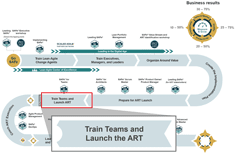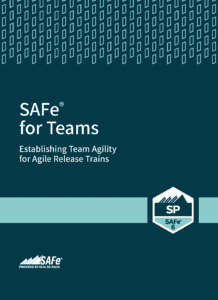
We often don’t think through carefully enough what new behavior, skills, and attitudes will be needed when major changes are initiated. As a result, we don’t recognize the kind and amount of training that will be required to help people learn those new behaviors, skills, and attitudes.
—Kotter
Train teams and launch trains.
—The SAFe approach
Train Teams and Launch the ART
This is article nine in the SAFe® Implementation Roadmap series. Click here to view the entire roadmap.
In the previous articles in the SAFe Implementation Roadmap series, we described the first eight’ critical moves’:
- Reaching the Tipping Point
- Train Lean-Agile Change Agents
- Create a Lean-Agile Center of Excellence (LACE)
- Train Executives, Managers, and Leaders
- Lead in the Digital Age
- Organize Around Value
- Create the Implementation Plan
- Prepare for ART Launch
By now, key ART stakeholders are trained and onboard, and launch plans are in place. The LACE and various SAFe Practice Consultants (SPCs) are ready and prepared to help. This article discusses how to train the teams and launch the ART so that the real business benefits of the change can start to occur.
Details
Kotter’s quote is a reminder that changing people’s behaviors, attitudes, and skills—and in the end, the culture of an enterprise—is no small feat. If people are to do things differently, leaders must “shape the path” [1]. That requires training to show people the way and follow-up coaching to help them master these new skills, techniques, and attitudes.
Train the Agile Teams
Now is the time to focus on the new and tentatively identified Agile Teams who will constitute most train members (see Prepare for ART Launch). These are the people who create the systems needed by the business, so it’s essential that they fully grasp what’s about to take place. They come from across the organization and have all the knowledge from business, development, operations, support, and other domains to define, build, test, and deploy their solutions. To be successful, they must understand their role in the ART and gain the Lean and Agile skills needed to be effective in their changing role. Likely, some or all have never participated in an Agile or SAFe environment, so the next significant task is to train all the teams in the SAFe way of working.
Scaled Agile, Inc.’s two-day SAFe for Teams (S4T) course is designed for this purpose. This team-building and training course features an introduction to Agile development, including an overview of the Agile Manifesto and its values and principles. It also includes:
- The core responsibilities of an Agile team and Agile Release Train (ART) an exploration of the roles of Scrum Master/Team Coach and Product Owner
- The purpose and mechanics of the essential events for their chosen team method, SAFe Scrum or SAFe Team Kanban
- Preparation for PI Planning
- Understanding the events which enable value flow and how to measure and accelerate flow as in each Agile Team and the ART
In addition, teams prepare their Team Backlog, which identifies the work needed for the upcoming PI planning event.
When approaching this training, keep in mind that it’s likely many of the team members will have some degree of experience with Agile development and might feel that they are already equipped to work in SAFe. There could potentially be some resistance to what they might consider more basic Agile training. However, this team training is critically important for SAFe success. In particular, there are several elements of team agility at scale that are unique to SAFe. These include:
- The role of the team in PI planning, Inspect and Adapt (I&A), and the IP iteration
- Focus on and participate in the System Demo
- Applying Features, user stories, and acceptance criteria to define and validate system behavior
- Applying the Core Responsibilities of SAFe Agile Teams
- Understanding the flow of work through the connected backlog systems
- Collaboration with other teams and other roles, including the Business Owners, Release Train Engineer, Product Management, and System Architects
- Introduction/application of Built-In Quality practices, including the Continuous Delivery Pipeline
- Building the larger team of teams that constitutes the ART
The Benefits of Big Room Training
In some rollouts, training is performed team by team over time. That can sometimes be effective. However, a more accelerated approach is strongly recommended and proven, which includes training all the team members simultaneously. This practice has raised some eyebrows in the industry. Many picture 100-plus people in a room being trained simultaneously, compare it to the more intimate setting of a small team with a single instructor, and can’t imagine that it delivers equivalent benefits. In reality, it provides far more value, for example:
- Accelerated learning – This training happens in two days rather than over months. That speeds up the timing and assimilation by all the train members, which accelerates the launch.
- A common scaled Agile paradigm – All team members receive the same training, at the same time, from the same instructor. This eliminates the variability of different training sessions by different instructors using different courseware over time.
- Cost-efficiency – One of the challenges with Agile implementation at scale has been the availability and expense of training. Talented, proven instructors are hard to find and not consistently available, and their value and cost are commensurately high. The Big Room approach is typically three to five times more cost-effective than individual team training.
- Collective learning – There is no substitute for big room training learning experience. Face-to-face interaction is one of the critical ingredients of Agile at scale. Training everyone together starts building the social network that the ART relies upon and creates a far better experience than what can be accomplished when working separately. There can be a transformative aspect to it, something you have to experience to believe.
To create a feel for what’s possible, below are some observations from Mark Richards, SAFe Fellow and a SAFe pioneer in Australia.
How on earth do you get a high-impact training experience with 100 people in the room? I was initially unconvinced, so I worked with my clients to schedule four or five SAFe team-level courses over the period leading up to the first PI planning. I’d request that they send entire teams to the same course so they could sit and learn together, and they would promise to do their best. Then the pain would start. Firstly, the teams would often be in flux up until the last moment. Then they would be too busy on current commitments to all come together, so they would dribble through two or three at a time. And distributed team members would go to different courses.
But I eventually got convinced enough to try it. After the first big room training, I was blown away and spent some time sorting through how on earth it could be so powerful.
—Mark Richards, SAFe Fellow, Australia
Here are some of Mark’s insights:
- The teams will be fully formed – The whole team can sit at the same table, virtual or physical. Not only do they get to learn together and share insights, it’s actually a very powerful team formation event. Teams choose their names on day one, and we watch team identity grow immediately.
- Teams engage in collective learning – This allows them to resolve their different interpretations in discussions and exercises. They’re not reliant on one mind—the Scrum Master/Team Coach—to ensure they get value from the Agile approach. Instead, they have many perspectives, and each captures different nuances.
- The features for the PI will be ready – The team training exercises involving the identification, splitting, and estimating of stories are done on the actual features the teams will be dealing with in PI planning.
- Teams form their own identities – Teams sit together, choose a name for their team, and begin creating the ART’s shared identity. As team discussions and exercise debriefs occur, they learn about each other’s worlds.
As different as it is, the all-in, big-room training approach remains a strong recommendation and is one of SAFe’s most cost-effective and valuable implementation strategies. This value holds true in a virtual classroom setting or in person.
Launch the ART
There are many ways to start an ART successfully, and there’s no specific timeline for the readiness activities described in the last article. However, experience has shown that the easiest and fastest way to launch an ART is through the Quickstart approach, as illustrated in Figure 1.
In this approach, the Agile teams are trained, and the first PI planning session is scheduled in a single week. While this may seem daunting, many implementations have shown that this is the easiest and most pragmatic way to help 100-plus people transition to the new way of working. There are three elements to this approach:
- Day 1 – 2 – The Agile Release Train attends big room training with SAFe for Teams, as described above.
- Day 3 – 4 – Training is followed immediately by PI planning. This way, the teams are still present and in context, and their first PI planning experience builds on the previous day’s training.
- Day 5 – This day is reserved for mentoring people in their new roles, tool training, discussion of needed Agile technical practices, open space, and any other activities the teams need to prepare for the first iteration.
The First PI Planning Session
During the Quickstart, PI planning serves to help build the teams’ backlogs based on current priorities. It also reinforces the training they’ve just received. Next week, the teams will plan their iteration in the normal fashion and start executing the PI.
Getting off to a good start with PI planning is essential to the success of the first PI. It demonstrates a commitment to the new way of working for all the teams and stakeholders. An effective session will:
- Build confidence and enthusiasm in the new way of working
- Start to build the ART as a team of Agile teams and the social network that it relies on
- Teach the teams how they can assume responsibility for planning and delivery
- Create complete visibility into the mission and current context of the solution
- Demonstrate the commitment of Lean-Agile Leaders to the SAFe transformation
Therefore, this first planning session is critical for SPCs, other leaders, and change agents. To ensure a good outcome, an experienced SPC will typically co-facilitate the session, coaching the RTE along the way.
Moving Forward
With the teams and stakeholders trained and the new way of working now in effect, there’s no going back. As organizations prepare to evolve and improve their practice of SAFe, they should keep this in mind: the fact that people have been initially trained in Agile doesn’t make them Agile. Just as Agile value delivery is incremental, so is becoming Agile. A mindset of continuous learning and inspection and adaptation is now essential to the health and well-being of the ART and the enterprise’s business goals.
It’s important to actively support the individuals who make up the ART and provide them with an environment in which learning and growing are encouraged. To leave them to their own devices would be against the responsibility of Lean-Agile leaders and change agents. They need to coach people on this new path, so everyone will be empowered to excel in this new working environment. That is the subject of the next article in this series, Coach ART Execution.
This article serves as a launching pad to explore these steps in detail and understand how to apply them to specific implementations.
Learn More
[1] Heath, Chip, and Dan Heath. Switch: How to Change Things When Change Is Hard. Crown Publishing Group, 2010.
Additional Resources
Last update: 12 December 2022

